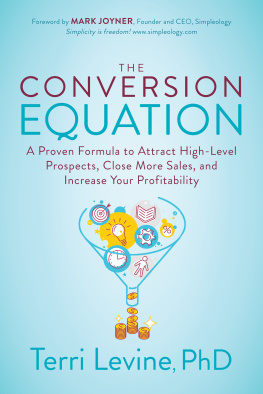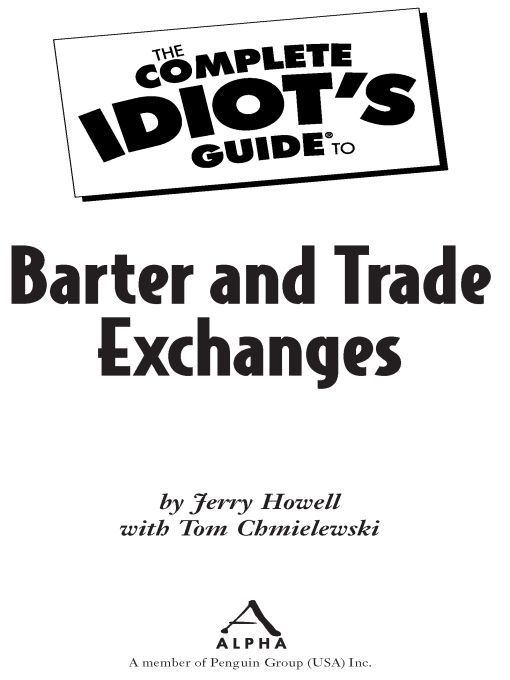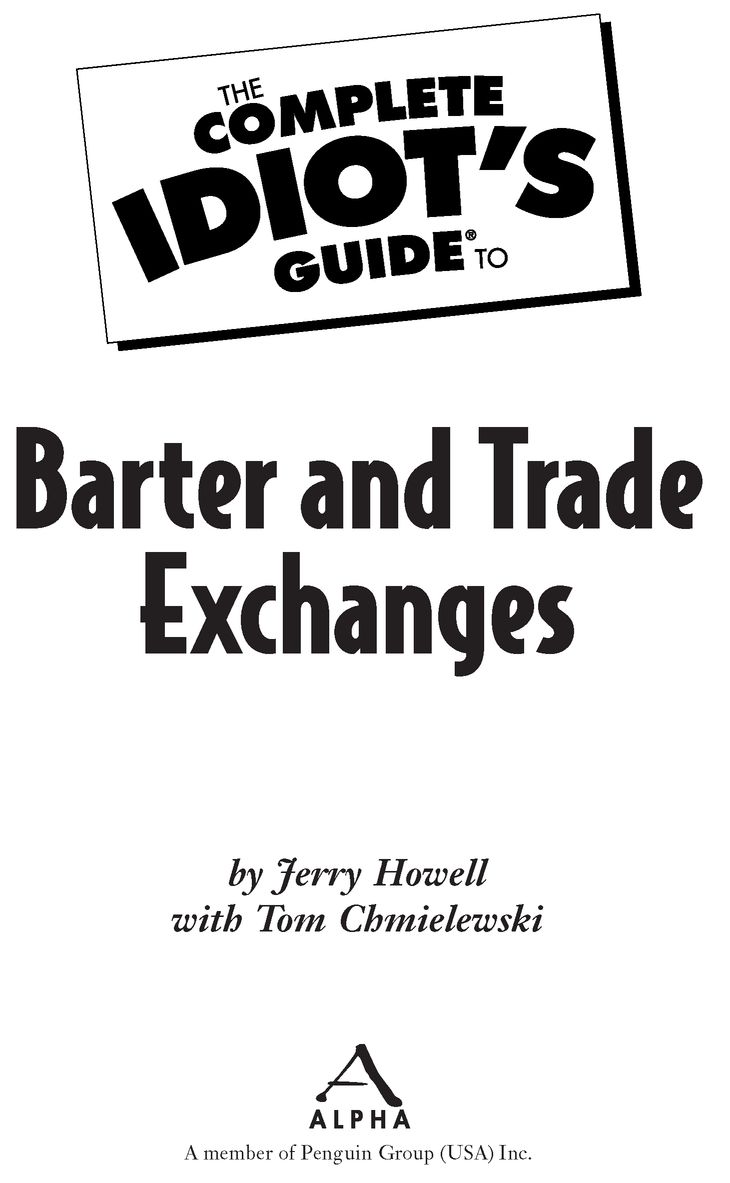Table of Contents
Introduction
There is a $10 billion per year barter industry in North America, according to reports from the U.S. Commerce Department and trade association officials. Industry sources estimate there are nearly 500,000 members of trade exchanges in the country, and perhaps 30 percent of the worlds total business is conducted through barter. Other estimates suggest one third of all small businesses in the United States use some form of barter.
Then theres the growth of community dollar groups across the country, taking shared trade to the personal level.
Barter is an ancient form of transaction that never got old, and continually adapts to the times. In this book, we go over how to use barter to your advantage, particularly for businesses looking to improve their cash flow and increase profits. Much of the book focuses on business-to-business transactions conducted through commercial trade exchanges.
How to Use This Book
We review the forms of barter, including direct trades, community dollars, and trade exchanges. All barter transactions involve an alternative form of currency. That alternative can give specific advantages to both the buyer and the seller, and unique opportunities to realize profit.
The book is organized into five parts:
Part 1, Barteran Alternative Currency, takes a quick look at barters history and how it naturally transformed into currency. Yet barter is not obsolete, evolving instead to various forms of community-based and business-to-business barter economies that supplement the broader cash-based economy.
Part 2, Trade Exchanges, covers the companies that run local and regional business-to-business barter activity. Businesses become members of an exchange so that instead of depending on direct trade for their barter activity, they broaden their reach through the use of trade dollars.
Part 3, Barter Strategies, advises you on how best to use barter and even when not to use it.
Part 4, Advanced Trade Techniques, points out ways you can use barter to leverage highly profitable deals. But be warned: these techniques require creativity, hard work, and careful monitoring to make the deals pay off.
Part 5, Start Your Own Trade Exchange, is for those readers who want to go deeply into bartering and run their own trade exchange. As the owner of a trade exchange, you need to run your own barter economy, balancing the amount of trade dollars in circulation, growing and servicing membership, and brokering deals. Theres no one way to run a trade exchange, but there are some common questions you need to answer.
Extras
Within each chapter are notes to help guide the reader through the ins and outs of barter.
definition
These boxes contain terms and phrases that have specific meanings for trade exchanges and direct barter.
Barter Bits
These sidebars include tips, insights, and trivia to make barter work for you.
Balance of Trade
Here you find advice and cautions to prevent your trades from undermining your cash flow.
Trade Tales
These boxes contain anecdotes that show how people, businesses, and organizations have used barter to their advantage.
Acknowledgments
Id like to acknowledge some people, who, without their assistance, friendship, and support, this book would have been impossible.
When I first started Midwest Business Exchange, there were some members who not only supported me, but I learned from them. Id like to thank Butch Shearer and Ted Klinger from Pappys, John Brown from Park Lane Florists, and from Portage Printing, Bob and Sue Nicol, and Craig Vestal. Id also like to thank Art Pearce and Bruce Woerner from Battle Creek Area Habitat for Humanity.
Id also like to thank some special friends in the barter industry, including Tom McDowell, Jack Schacht, Fran Crumpton, and Alan Zimmelman. Their assistance and input into the book were invaluable. Special gratitude goes to my team of Omar Towghi, Lance Dorsey, Dave Forster, and Jim Coash, who also contributed.
I would particularly like to thank Tom Chmielewski for his time, talent, and expertise.
Finally, Id like to thank my familymy dear wife Liz and our two daughters Shantal and Amandaas they not only encouraged me to write the book, but also supported me throughout the process.
Jerry Howell
Trademarks
All terms mentioned in this book that are known to be or are suspected of being trademarks or service marks have been appropriately capitalized. Alpha Books and Penguin Group (USA) Inc. cannot attest to the accuracy of this information. Use of a term in this book should not be regarded as affecting the validity of any trademark or service mark.
Part 1
Barteran Alternative Currency
Cash has value only because we believe it has value. After all, a $1 bill has no inherent worth beyond the paper its printed on. But it represents the value of the goods it can buy.
People and businesses dont always have cash on hand, but they do have services they can provide, or goods in stock. People can use those goods and services to back their own form of currency in a barter economy, and theyve been doing it for thousands of years. In this part, youll learn how primitive barter developed into complex economies and how barter continues today in many forms.
Chapter 1
A History of Barter: I Have Water,You Have a Cow
In This Chapter
Barters beginnings: filling basic needs
Barter evolves into currency but never disappears
When a cash economy falters, people turn to barter
Trade exchanges bring in a new business model
Countertrade enters a global economy
We have all bartered. We remember times when as a school kid, we were bored with the lunch our moms packed for us, but salivated over the lunch the geeky kid across the table had. But he was just as bored with his moms culinary choices. So, we traded.
No one had to teach us how to do trade. It just came naturally to us. In fact, it came naturally to all of humanity. At a time when humanity was just becoming, well, human, the idea of trading occurred to someone who thought it might be easier to get something he needed by trading rather than beating someone over the head with a club and just taking it.
The idea of trade and barter never left us, even as we developed a more complex, money-based economic system over the millennia. Indeed, trade and barter is the basis of our economic system and still offers an alternative to cash.
Economy on the Hoof
When academics and historians trace the concept of barter and money, they go back to around 9000 B.C.E. and the first domestication of cattle. In this case, cattle can mean anything, from cows, to sheep, to camels. Cattle could assure a familys subsistence.










